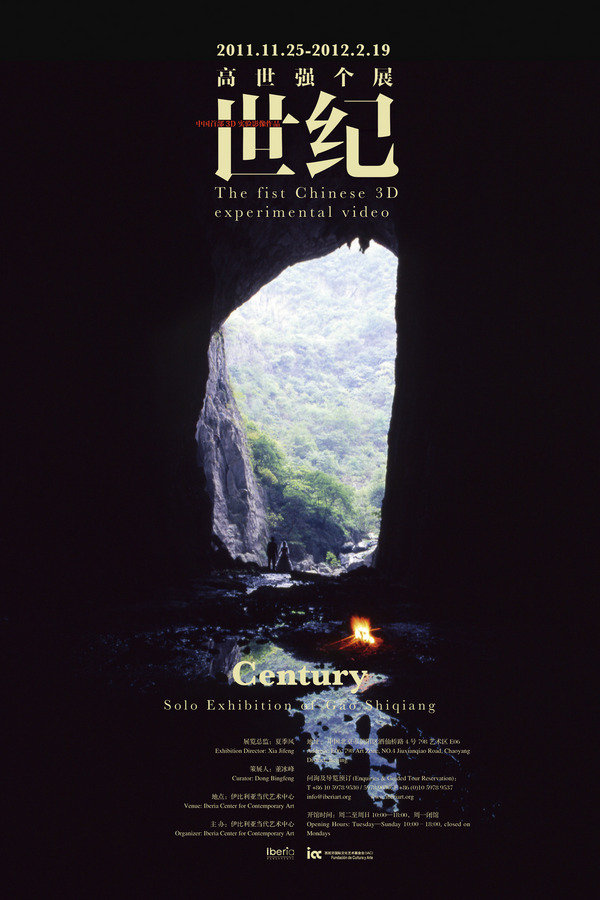Two exhibitions
dal 24/11/2011 al 18/2/2012
Segnalato da
24/11/2011
Two exhibitions
Iberia Center for Contemporary Art, Beijing
Three art video works by Gao Shiqiang: 'Total Solar Eclipse', 'Qingbang', and 'Century'. His art video works reveal a review and recognition of the reality that take place on a larger and more complex scale and form a certain system of knowledge and thinking. Tu Hongtao's painting in 'The Desire of Plants', the relationship between plants is not distinct but blurred. Therefore, the subjects are given more freedom to drift, which is undoubtedly more disturbing.

Gao Shiqiang
Century
Curator: Dong Bingfeng
Following “The Other There, Gao Shiqiang's solo” in 2009, Iberia Center for Contemporary Art will present his Century, another solo. As one of the "scholarly" artists in the contemporary art scene in China, Gao Shiqiang, born in 1971, now teaches at School of Trans-media, CAFA.
This exhibition will greet the audience with three art video works by Gao Shiqiang, i.e., Total Solar Eclipse, Qingbang, and Century. Following the artist's poetic logic of video, Total Solar Eclipse, shot in a newly built workshop abandoned soon after the economic recession, gives a spiritual portrait of contemporary Chinese people as a group; Qingbang, a three-screen video, focuses on how an age can finish and makes a place fall into oblivion; Century is the first experimental 3D video work in China, which, compared to 2D video, is capable of arousing strong sense of presence and immersion achieved through its overt graduation and spatial division. This modern technology in video-making greatly expanded human visual experience by isolating, alienating, or even creating a virtual video world. "The real" and "the unreal" of 3D video seem to be relevant topics, and are therefore potentially expressive in terms of practice.
Gao Shiqiang's art video works reveal that his review and recognition of the reality take place on a larger and more complex scale and form a certain system of knowledge and thinking. This exhibition is therefore an collection of his art practice and thinking in recent years, and also a brief summery of his understanding of art practice and video as an art form.
His experience in video making, stemmed mainly from the education he received at China Academy of Art and his passion for classical art, enables him to approach video making from the perspective of art video. His works therefore gradually find their way between "film and video art", which helps him to distinguish himself from those "common-sense" film directors.
During the exhibition, Dong Bingfeng, curator of this exhibition, and Gao Shiqiang will compile a "film book", in which there will be a great number of film illustrations, latest stage photos, and more importantly, a long dialogue between the curator and the artist on different forms of art practice and various concepts, covering a wide range of topics, such as the history of film, video art and art video.
Organizer: Iberia Center for Contemporary Art、Fundación de Cultura y Arte(IAC)
------
Tu Hongtao
The Desire of Plants
Curator: Zhu Zhu
Born in 1976, Tu Hongtao impresses the art world and the audience with his unique quality as an artist, such as the "bad boy" in him, light and lively brushwork, as well as the urban "live like" enhanced by the scenic setting and the narrative style of stream-of-consciousness. In reaction to the pictorial deficiencies common to the previous generation, he tries to "avoid being a repeated symbol" by highlighting thematically the participation in "the current of flowing time" while keeping certain distance — "enjoy it while criticizing" and "taste the pain while feeling happiness", as he put it.
It is typical of the situation and stand of the young generation, seemingly contradictory but extremely true. In their view, the absolute binary opposition is abandoned, the moral judgment is suspended, and art, as a text, begins to show its autonomy and capacity to produce pleasurable feeling in the aesthetic game.
Compared with his previous works dealing with the relationship of invasion and threat between human being and the city, his new works lighten narration and give the artist a balancing role, rather than a narrator. In The Desire of Plants, the spatial relationship between plants is not distinct but blurred. It becomes an open structure where expansion means more possibilities. Therefore, the subjects are given more freedom to drift, which is undoubtedly more disturbing.
Tu Hongtao began to destroy the connection by making use of the abstract negative space, thus allowing more space to the small items. This technique, which has a lot in common with the popular item-enlarging technique in the Chinese tradition, enables him to distinguish the space by means of abstract modeling. This way, the fragmented narration of urban sentimentality gives way to a new dimension of dialogue with the remote time and space, so that the traditional and natural elements become more conspicuous.
The dispersed and involved images and details are therefore checked by what he called "the negative space". The blank background, however, does not signify emptiness but extension of the mind, in other words, transcendence of the material quality of time. While offering more freedom to the individual, these works lead us further into our experience of the reality.
Contact for Media
T+86 10 59789030 media@iberiart.org
Opening: 4 p.m. Friday Nov. 25, 2011
Iberia Center for Contemporary Art
Zone E06, 798 Art District, No.4 Jiuxianqiao Road Beijing
Opening Hour
10:00—18:00 (Tuesday to Sunday) Closed (Monday)



